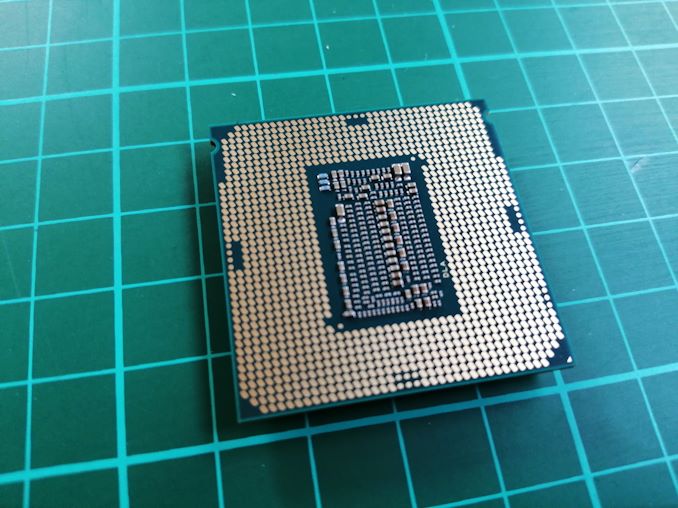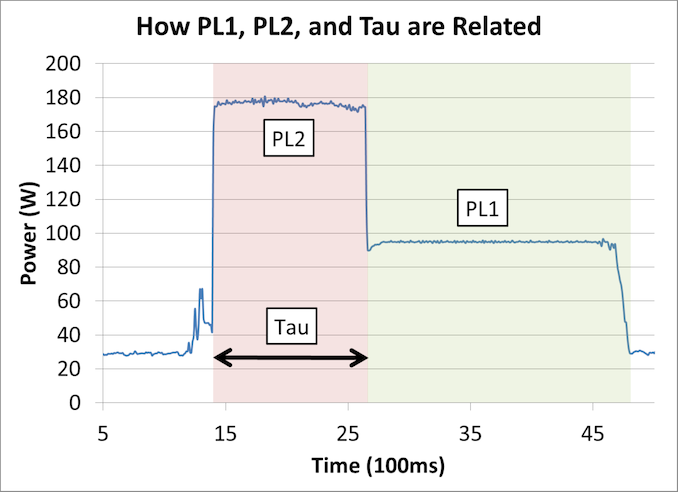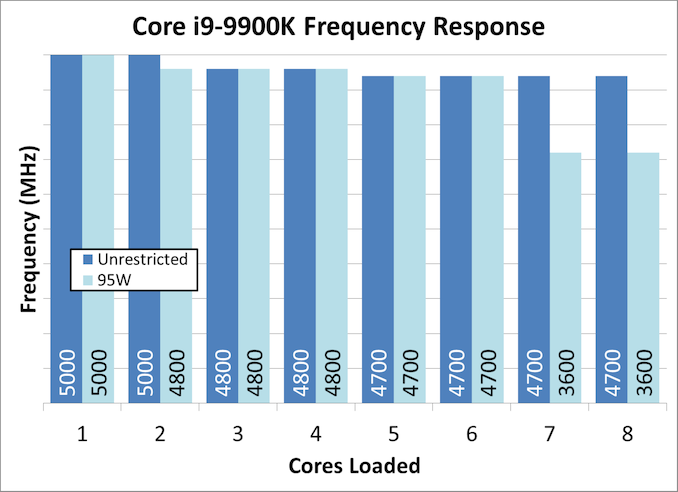The Intel Core i9-9900K at 95W: Fixing The Power for SFF
by Ian Cutress on November 29, 2018 8:00 AM EST
There is a lot of discussion about processor power recently. A lot of the issues stem around what exactly that TDP rating means on the box, and if it relates to anything in the real world. A summary of Intel’s official declaration boils down to TDP as the sustained processor power at long periods, however almost zero motherboards follow that guideline. As a result users will usually see much higher sustained power, although with much higher performance. Some small form factor systems rely on setting these limits, so we tested a Core i9-9900K with a 95W limit to see what would happen.
Intel and TDP
We recently published a sizeable analysis on what Intel officially means by TDP, and the associated values of PL1, PL2, and Tau. You can read it all here, although what it boils down to is this diagram:
When a processor is initially loaded, it should enter a state where PL2 describes the maximum power for a time of Tau seconds. When in this PL2 state, the CPU follows Intel’s per-core Turbo table rules, which reduces the frequency based on the number of cores loaded.
After Tau seconds, the CPU should drop down to a PL1 maximum sustained power value, which is usually identical to TDP. Depending on the CPU, this may reduce the frequency to the base frequency, or well below the all-core turbo frequency.
Technically PL2 is obtained over a moving average window, Tau, such that any low power moments on the processor will 'give budget back' to the turbo mode, however the graph above is the easiest way to see the high turbo mode on a fully loaded processor.
So while Intel defines a value for PL1, PL2, and Tau, almost zero consumer motherboard manufacturers actually follow it. There are many reasons why, mostly relating to overengineering the motherboards and wanting users to have the best performance at all times. The only times where these values follow any form of Intel guidance is in small form factor PCs.
For example, I tested an MSI Vortex G3 small form factor desktop at an event last year. It was using a processor normally rated for 65W TDP, and in a normal desktop that processor would push over 100W because the motherboard manufacturer in that system did not put any limits on the power, allowing the power to fall within Intel’s per-core turbo values. However, in this Vortex system, because of the limited thermal capabilities, the BIOS was set to run at 65W the whole time. This made sense for this form factor, but it meant that anyone looking for benchmarks of the processor would be misled – the power profile set in the BIOS was in no-way related to how that CPU would run in a standard desktop.
A Core i9-9900K with a 95W Limit
To put this into perspective, for this review we are using a Core i9-9900K which has a sustained TDP rating of 95W. When we compare the per-core frequencies of a 95W limited scenario and a normal ‘unrestricted scenario’, we get the following:
When a single core is loaded, the CPU is in 5.0 GHz mode as we are well under the power limit. There’s a slight decrease of 200 MHz in the 95W at two cores, but this disappears when 3-6 cores are loaded, with both setups being equal. The major difference happens however when we are at 7-8 cores loaded: because of the power consumption, the Core i9-9900K in 95W mode drops down to 3.6 GHz, which happens to be its base frequency.
This arguably means that we should see a correlation in most benchmarks between the two parts, but not if maximum load is ever required.
This Review
For this review, we’re putting the Core i9-9900K at a 95W power limit (as measured by the internal registers of the system) and running through our CPU test suite to see if how large the performance deficit is between the Core i9-9900K in a thermally unlimited scenario compared to a small form factor system deployment.
Pages In This Review
- Analysis and Competition
- Test Bed and Setup
- 2018 and 2019 Benchmark Suite: Spectre and Meltdown Hardened
- CPU Performance: System Tests
- CPU Performance: Rendering Tests
- CPU Performance: Office Tests
- CPU Performance: Encoding Tests
- CPU Performance: Legacy Tests
- Conclusions and Final Words












101 Comments
View All Comments
urbanman2004 - Thursday, November 29, 2018 - link
Yeah, the 9900K is the latest and greatest when it comes to mainstream CPU's, but at its current pricing you're better off purchasing a more value oriented CPU such as the 8700K to get more bang for your buck. Intel has been losing their sh!t as of late ever since AMD's Ryzen has them on their heels.AlyxSharkBite - Thursday, November 29, 2018 - link
The 9900K is awesome if you build a rig that can keep it cool when overclocked. But otherwise yeah an 8700K is a better choice or for bang for buck the 2700X is good4800z - Thursday, November 29, 2018 - link
It's not that hard to cool it. Just need a big noctua or an AIO.TheinsanegamerN - Thursday, November 29, 2018 - link
It still runs high 90C under OC on such coolers. The only way to keep it running at a 5 GHz OC with with a 360mm rad, and even then just barely.The 9900k is the hardest intel to cool since the pentium DEE
4800z - Thursday, November 29, 2018 - link
If you want value stop playing games and get a part time job so you can have more money in your pocket. The 9900k is only a few hundred dollars more. THat's not much spread over years.sa666666 - Thursday, November 29, 2018 - link
Found the Intel shill/apologist. Not everyone has unlimited funds to spend like that, and even if they could afford the CPU, what about the power to run it? This CPU is very power-hungry and expensive, and insulting users that don't have a lot of money (or have a better sense of how to properly budget it) won't change that fact.schujj07 - Thursday, November 29, 2018 - link
Very true. Has to justify the reason for spending an arm and a leg on his/her new space heater. 4800z while the CPU is $200 more expensive, you also need the $70+ cooler, you have to have the expensive z390 motherboard that adds another $70 onto the build, your room is going to be warmer so that will increase your cooling costs, and drawing 77% more power means you are going to increase your electric bill. All these costs add up and unless you are able to purchase this on a credit card with 0% interest or have saved up for a long time, the extra $400 is going to make a huge difference. Also someone could go with the 2700X or 8700K and use the extra $400 for a nice upgrade on their build, where said person would have gotten a RTX2080 not s/he can afford a RTX2080Ti.TEAMSWITCHER - Thursday, November 29, 2018 - link
He's not wrong. The 9900K is closer the Thread Ripper in many benchmarks than Ryzen is to the 9900K, and at the same time closer to Ryzen in cost. While billed as a gaming processor, the 9900K is great for content creators. Unless you have a specific need for HEDT platform capabilities (RAM or PCIe lanes) the 9900k would get the job done for less money.Targon - Thursday, November 29, 2018 - link
And if you just wait until March of 2019, Ryzen 3rd generation will probably meet or beat the performance of the 9900k for $330. So your $200+ higher price will only be for 4-5 months of having superior performance before the new AMD will be considered faster.HollyDOL - Saturday, December 1, 2018 - link
I know a person holding to a similar philosophy. He still runs Athlon XP, always waiting for the next generation beating the current one.